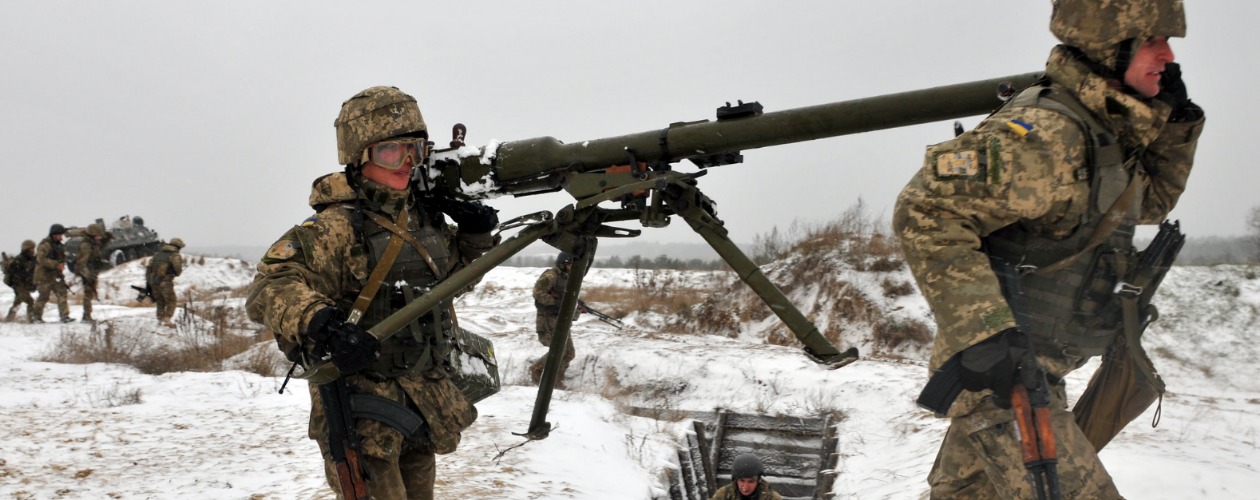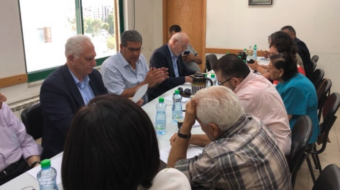
The war danger in Ukraine is escalating, and once more it is Washington and the NATO military alliance it controls which are raising the stakes in this deadly gamble.
President Joe Biden ratcheted up tensions this weekend with the revelation that he plans to possibly dispatch as many as 50,000 troops—along with tanks, missiles, aircraft, and warships—to NATO military allies in the Baltic states and Eastern Europe.
The U.S. has also issued marching orders to other NATO members. Secretary of State Antony Blinken, the Biden administration’s top propaganda chief on the Ukraine matter, said Sunday that “NATO will continue to be reinforced…if Russia commits renewed acts of aggression.”

Already, there are F-16 warplanes from Denmark on the way to Lithuania, Spanish fighter jets and naval forces en route to the Black Sea, French troops airlifting to Romania, and Dutch F-35 fighters joining the patrols in the skies over Bulgaria. These military moves were paired with diplomatic theatrics, as the U.S. and Britain began “evacuations” of some embassy staff in Kiev.
But what are the new supposed threats from Russia that merit kicking the U.S.-led war machine into high gear?
Biden insists Russia could “move in” on its neighbor at any minute but offers no information about anything new when it comes to Russian military developments. It’s been public knowledge for weeks that Russian forces have taken up positions at the country’s western borders, but the government of President Vladimir Putin continues to deny it has any intention of invading Ukraine.
Instead, it points the finger back at NATO, saying the accusations against Russia are a cover for the military alliance’s own provocations—those already underway and those still planned. Dmitry Peskov, spokesperson for the Kremlin, told the media this weekend, “All this is happening not because of what we, Russia, are doing. This is happening because of what NATO and the U.S. are doing.”
One doesn’t have to be a fan of the authoritarian and oligarchic state run by Putin to see that Russia’s claims have some merit. The current crisis is underpinned by major issues that stretch back over the past 30 years—from the end of the Cold War to the present—and which are receiving little to no attention in the mainstream press.
Facts and fiction
First is the prolonged instability that has defined Russian-Ukrainian relations since the dismantling of the socialist Soviet Union in 1990-91. For hundreds of years, Russia and Ukraine have been tied together—socially, culturally, politically, and in every other imaginable way. The two Slavic countries even share an origin point in the Kievan Rus state that came into existence in the area around modern Kiev more than a millennium ago. Over centuries, their people intermarried, fought off Napoleon, the Kaiser, and Hitler together, and built an advanced modern industrial economy.
Those connections were severed by the fall of the USSR. In other regions, the destruction of the Soviet Union saw the outbreak of violent ethnic and religious conflicts when communities were suddenly split apart or forced together by nationalist regimes. The war between Armenia and Azerbaijan last year is only the most recent example.
For Ukraine, the current downward spiral in relations with Russia started in 2014 when a coup by U.S.-and European Union-backed ultra-nationalist and fascist forces overthrew the elected (but undeniably corrupt) government of supposedly pro-Russian President Viktor Yanukovych. The U.S. and its allies claim it was Moscow’s man Yanukovych who forced the turn toward violence and confrontation when his security forces opened fire on protesters in Kiev’s Maidan square in February that year, killing 50 people.

The so-called “sniper’s massacre” has been held up as the trigger for everything that followed, including Yanukovych’s removal from power, the “civil war” in eastern Ukraine, and the Russian “annexation” of Crimea. However bad Yanukovych may have been, as more evidence comes to light, the “sniper’s massacre” is looking more and more like a fascist frame-up rather than the desperate act of a soon-to-be-deposed dictator.
Extensive research from University of Ottawa Professor Ivan Katchanovski is upsetting the narrative pushed by the West and its allied regime in Kiev. Looking at the testimony of over 100 wounded demonstrators, dozens of prosecution witnesses, the examinations of the Ukrainian government’s own forensic and ballistic experts, and hours of videotapes, Katchanovski has concluded that the massacre of the “absolute majority of protesters and police” at the Maidan was perpetrated by “members of the Maidan opposition, specifically it’s far-right element.”
In simpler terms: It was the fascist forces supported by the West, not the Russian-backed Yanukovych, who fired the opening shots in the violence that has since killed more than 13,000 people. The truth about the “sniper’s massacre,” according to Katchanovski, has been repeatedly “misrepresented, omitted, or even covered up by Western governments and…the mainstream media.”
If the very first line in the Western powers’ story about Ukraine is a lie, it becomes prudent to look at everything they’ve said since with a skeptical eye. That includes everything they’re saying now.
For instance, the government of British Prime Minister Boris Johnson—which is on the ropes at home and could fall at any time—claimed on Saturday that Moscow was plotting to install a “pro-Russian” leader in Ukraine. Conveniently, the figure Putin allegedly plans to tap to run a puppet regime is Yevgeniy Murayev—a former MP who opposed the fascist-backed coup of 2014, has long been an ally of Ukrainian trade unions, and is now a leading voice speaking out against the war danger.
Murayev believes the Ukrainian government is selling the country’s future to the U.S., whose weapons makers he said are whipping up the war hysteria to reap whirlwind profits. “The hawks are looking forward to a feast,” he wrote. Biden’s big troop and armaments deployments seem to fit the bill. It’s little wonder then that London and Washington are trying to link Murayev to Putin and derail his anti-war party from gaining public support.
Like the “sniper’s massacre,” the claims about the planned installation of a pro-Kremlin puppet start to look suspiciously like the Western powers accusing Russia and its friends of exactly the things they themselves have done and are doing.

Who is the true aggressor?
Beyond the disputes internal to Ukraine, there are also the international roots of the conflict. Way back in 1991—more than three decades ago—the administration of President George H.W. Bush made a pledge to Soviet President Mikhail Gorbachev that when the military forces of the USSR withdrew from Eastern Europe, NATO would not seek to add countries there to its ranks.
If the West had truly been interested in creating the conditions for a lasting peace in that moment when the Cold War was ending, it would have dissolved NATO completely. The Soviet-led Warsaw Pact was liquidated, but the U.S. and its allies didn’t respond in kind.
In fact, they barely wasted a minute to prove that Bush’s promise was a lie—not only expanding into former Warsaw Pact countries like Poland, the Czech Republic, Slovakia, and Romania but actually gobbling up nations that were formerly part of the USSR itself, like Latvia and Lithuania.
With the excuse of being a “defensive” alliance against the Soviet Union gone, NATO was openly refashioned into a direct instrument of U.S. military priorities. NATO helped tear the country of Yugoslavia into pieces, bombarded Afghanistan after Sept. 11th, assisted in the U.S. occupation of Iraq, and assisted in pushing Libya into a civil war.
Given this history, Russia’s fear of NATO pulling Ukraine into its sphere and creeping directly up to the Russian border is far from absurd. It is little wonder that Putin demands the U.S. and NATO remove all weapons from Ukraine, that a guarantee be issued Ukraine will not join the alliance and the security of all former Soviet nuclear weapons on Ukrainian territory. Any Russian leader—left, right, or center—would ask the same.

Negotiation is the only way out
Unless the Biden administration wants to force an open military conflict, it must accept that a negotiated settlement is the only solution—and that settlement has to include no NATO membership for Ukraine.
The war hawks in the military-industrial complex and their political spokespersons in Congress are of course pushing for further escalation. The threat of war alone has already been enough to bring the cash rolling in for the weapons makers.
Even if Biden is not inclined to listen to the advice of an anti-war outlet like People’s World, he should at least heed the advice of the so-called foreign policy “realists” of establishment think tanks such as the Quincy Institute. Its working group of “former American and British ambassadors and experts on Russia and Ukraine” says an actual Russian invasion of Ukraine is not in the cards, despite the screaming of the media, and that Washington has to issue a “moratorium on further NATO expansion” for at least the next few decades.
Lyle Goldstein, an analyst at the military think tank Defense Priorities, has given the administration similar counsel. U.S. intervention would have “deleterious and even catastrophic consequences,” he argues. Even indirect interference, such as providing more weapons to the Ukrainian government, Goldstein says, would “further cement the ‘New Cold War,’ prolong the war and the killing” and push Russia to look for other ways of protecting itself militarily.
Acknowledging the necessity of halting NATO expansion into Ukraine does not represent a concession to Putin; it is a concession to common sense. Nor does it compromise the self-determination of the Ukrainian people. The truth is that the West compromised on that in 2014 when it helped install a fascist-backed government in Kiev.
It’s now up to President Biden and his NATO allies to bring us all back from the precipice of war.
MORE PEOPLE’S WORLD COVERAGE ON UKRAINE:
> Dark days for Ukraine’s left
> U.S. sends forces to train Ukraine National Guard, communists repressed
> U.S. and NATO play with fire in their latest anti-Russia campaign
> The facts about Ukraine that no one mentioned during the impeachment trial
> Ukrainian rightists burn alive 39 at Odessa union building












Comments